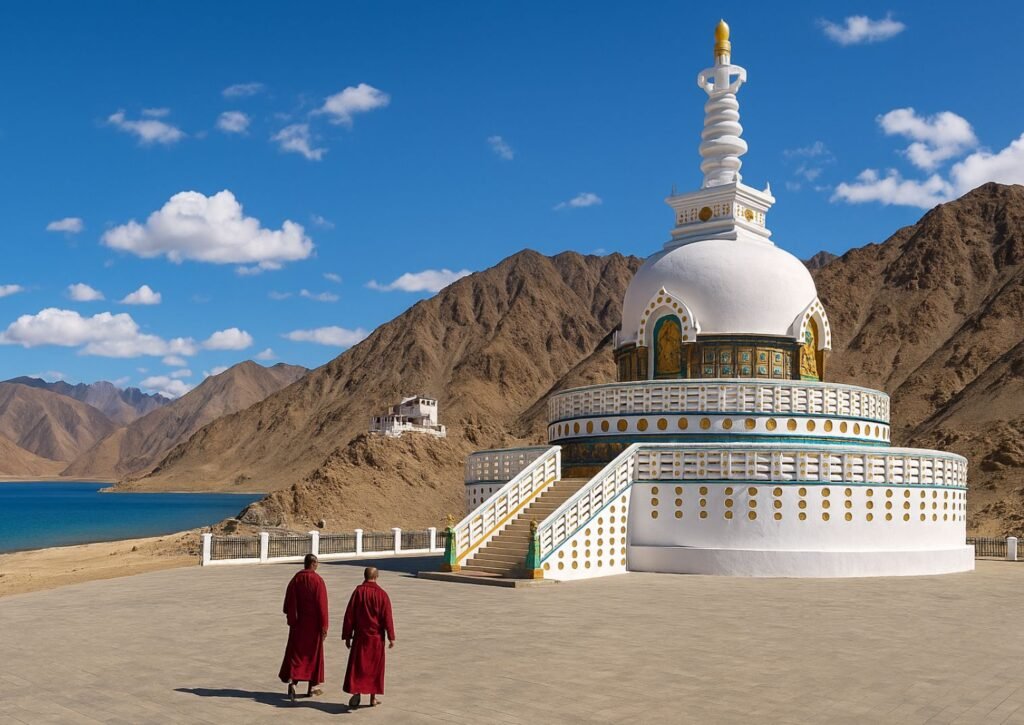A Leh trip is an unforgettable journey through one of the most breathtaking and remote regions of India. Tucked away in the Union Territory of Ladakh, Leh stands at the crossroads of ancient Tibetan culture, stark Himalayan landscapes, and adventurous escapades. For travelers seeking a mix of serenity, spirituality, and scenic beauty, Leh offers an unmatched experience.
Arrival in Leh : A High-Altitude Welcome
Most travelers reach Leh by air, landing at the Kushok Bakula Rimpochee Airport, one of the highest airports in the world. The descent offers stunning aerial views of brown, barren mountains sliced by winding rivers. Given Leh’s high altitude (11,500 ft), acclimatization is crucial. Most visitors spend their first day resting and sipping butter tea, allowing their bodies to adjust to the thinner air.
Monasteries and Spiritual Vibes
Leh is steeped in Buddhist culture, and its many Gompas (monasteries) reflect this deep spiritual heritage. The Thiksey Monastery, often compared to Tibet’s Potala Palace, is a 12-story complex that offers panoramic views of the Indus Valley. Hemis Monastery, the largest and richest in Ladakh, is also worth a visit, especially during the Hemis Festival, which features traditional mask dances.
Other sacred sites like Shey Palace, Spituk Monastery, and Shanti Stupa contribute to the region’s meditative atmosphere. Whether or not one follows the Buddhist faith, these monasteries offer a peaceful escape and cultural immersion.
Adventure and Scenic Drives
One of the highlights of a Leh trip is the chance to journey through some of the highest motorable roads in the world. A drive to Khardung La Pass, perched at 18,380 feet, is thrilling and offers jaw-dropping views of snow-clad peaks and deep valleys. For those who crave even more, the road to Chang La Pass on the way to Pangong Lake is equally dramatic.
Pangong Lake, made famous by Bollywood films, is a surreal stretch of blue surrounded by rugged mountains. Its colors change with the shifting sunlight, creating an otherworldly palette. Equally mesmerizing is Tso Moriri Lake, a lesser-visited gem ideal for travelers looking to escape the crowds.
Culture, Cuisine, and Local Life
Leh is a melting pot of Indo-Tibetan culture, visible in its people, festivals, and food. A walk through Leh Market introduces visitors to vibrant handicrafts, woolen garments, traditional jewelry, and Tibetan artifacts. Local eateries serve up warming delicacies like thukpa (noodle soup), momos (dumplings), and butter tea.
For those interested in learning more about the region’s history, the Hall of Fame Museum (maintained by the Indian Army) and Leh Palace, modeled after Lhasa’s Potala Palace, offer deeper insight into Ladakh’s past and its strategic importance.
Practical Tips for a Leh Trip
- Best Time to Visit: The ideal months are May to September, when roads are open and the weather is pleasant.
- Permits: Some areas like Pangong Lake and Nubra Valley require Inner Line Permits (ILP) for Indian citizens and Protected Area Permits (PAP) for foreigners.
- Health: Stay hydrated, eat light, and avoid alcohol for the first 24 hours to minimize altitude sickness.
- Connectivity: Mobile connectivity is limited. BSNL and Jio are the most reliable networks in Leh.
A Destination That Stays With You
A Leh trip is not just about high-altitude adventure; it’s about connecting with a place where nature, culture, and spirituality coexist in perfect harmony. From the silence of the mountains to the chants in ancient monasteries, Leh offers a sense of peace and wonder that few destinations can match.
Whether you’re a thrill-seeker, a nature lover, or a culture enthusiast, Leh will leave you awe-inspired, rejuvenated, and dreaming of your return.
–
*This blog is written by Team Curating Experience.


